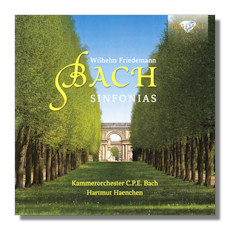
The Internet's Premier Classical Music Source
Related Links
- W.F. Bach Reviews
- Latest Reviews
- More Reviews
-
By Composer
-
Collections
DVD & Blu-ray
Books
Concert Reviews
Articles/Interviews
Software
Audio
Search Amazon
Recommended Links
Site News
 CD Review
CD Review
Wilhelm Friedemann Bach

Sinfonias
- Sinfonia in F Major "Dissonant", Fk 67
- Sinfonia in F Major, Fk 88
- Sinfonia in D Minor, Fk 65
- Sinfonia in D Major, Fk 64
- Sinfonia in D Major, Fk 91
- Sinfonia in G Major, Fk 92
- Suite in G Minor, BWV 1070
C.P.E. Bach Chamber Orchestra/Hartmut Hänchen
Brilliant Classics 94690
One of the most useful things which a listener to this engaging music by Johann Sebastian's second child and eldest son can do is try and strip away their awareness of the developments in music since the middle of the Eighteenth Century to see just how ahead of its time Wilhelm Friedemann Bach's writing was. Yes, his father's "Brandenburgs" had given the same prominence to the timbre and qualities of individual instruments as does – for instance – the poco allegro movement, the "Sinfonia in F Major, Fk 88" [tr.5] here. But Friedemann takes more about the role of individual sounds for granted. Their attributes are in his blood; and he exploits them very naturally and effortlessly.
At times his control of the interplay between winds and winds and strings is almost redolent of the way in which the middle period Beethoven orchestra was managed. Friedemann gives a luminance to the flute in the lovely, extended adagio, the "Sinfonia in D Minor, Fk 65" [tr.6]. It's also almost worthy of Sebastian's heavenly elevation of the instrument's tone. Yet one has to think forward to the way in which the Romantics treated such soloists before encountering such exposure again. Yet again, the fugue which follows in the same movement has more in common with Mozart than Friedemann's presumed models.
In fact, Wilhelm Friedemann Bach was very much his own person; indeed, he sadly took dissolution to excess, dying in poverty before Mozart did. But those unfamiliar with his work could well be amazed – surely very pleased – to discover its breadth and depth. The six Sinfonie and one Suite on this attractive CD from Brilliant played by the unfortunately still too obscure Carl Philipp Emanuel Bach Chamber Orchestra (CPEBCO) could be a revelation. Although recordings of Fk 64, Fk 65, Fk 67 and BWV 1070 (formerly attributed to Friedemann's father, hence its numbering) are available elsewhere – and in good period instrument performances, notably by Tafelmusik (Sony Vivarte SK62720) – the CPEBCO does an excellent job on this reissue of recordings made over 20 years ago.
While Fk 65 and Fk 67 are extant works in the "Sinfonia" format, Hänchen and his colleagues undertook what he describes as the "exceedingly complex" task of reconstructing and arranging Friedemann's cantatas for the remaining four. They work well and are as faithful as we could hope. Much of the composer's work has either been destroyed or is hoped to remain hidden and/or otherwise as yet undiscovered. The quality of these arrangements can only whet our appetite.
As its name sugests, the CPEBCO specializes in music of Carl Philipp Emanuel Bach, and his contemporaries. It was founded in 1969; when Hartmut Hänchen took over as artistic director in 1982 he expanded its repertoire to both early music and that of the twentieth century. The two dozen or so musicians mostly also play in orchestras in Berlin. This breadth of repertoire and experience shows in the confidence with which they tackled the music of Wilhelm Friedemann here. There's a "swing" and a confidence which pulls the listener along nicely. Yet these do not obscure the music's subtleties.
There is a bloom, a freshness, a projection in their playing, then. They don't push the music at us. But their approach is more pointillist than impressionist. Ultimately the performances will only really work – especially given their provenance – if a sense of the whole, of the structure of the works, is retained. This is the case here; and makes for compelling listening. The sequence of movements and works also lends variety to the CD. On the one hand each work is complete and satisfying. But on the other, by the end of the G minor Suite the musicians have conveyed a sense of the strengths of a composer who deserves to be heard much more.
The acoustic on the just over an hour long CD is good. It's not too forward yet adds to the sense of presence that so benefits this expressive music. The booklet also contains an informative introduction to the music and its context by Hänchen himself. This is music full of both delight and depth played with vigor and precision. Recommended.
Copyright © 2014, Mark Sealey


















